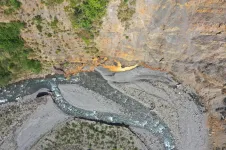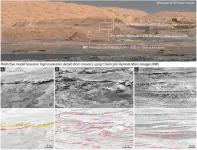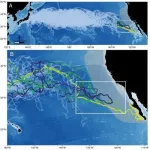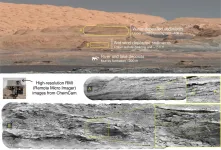Mountain growth influences greenhouse effect
Weathering of rocks can bind or release carbon dioxide -- in active mountain ranges, carbon-dioxide release strongly dominates
2021-04-08
(Press-News.org) Taiwan is an island of extremes: severe earthquakes and typhoons repeatedly strike the region and change the landscape, sometimes catastrophically. This makes Taiwan a fantastic laboratory for geosciences. Erosion processes, for example, occur up to a thousand times faster in the center of the island than in its far south. This difference in erosion rates influences the chemical weathering of rocks and yields insights into the carbon cycle of our planet on a scale of millions of years. A group of researchers led by Aaron Bufe and Niels Hovius of the German Research Center for Geosciences (GFZ) has now taken advantage of the different erosion rates and investigated how uplift and erosion of rocks determine the balance of carbon emissions and uptake. The surprising result: at high erosion rates, weathering processes release carbon dioxide; at low erosion rates, they sequester carbon from the atmosphere. The study will be published in Nature Geoscience.
Behind all this are tectonic and chemical processes. In rapidly growing mountains in particular, tectonic uplift and erosion constantly bring fresh rock material up from underground. There it is exposed to circulating acidic water which dissolves or alters the rock. Depending on the type of rock, this weathering has very different effects on Earth's climate. For example, if carbonic acid from the soil comes into contact with silicate minerals, limestone (calcium-carbonate or CaCO3) precipitates, in which the carbon is then bound for a very long time. In the case of a combination of sulfurous mineral, such as pyrite, and limestone, the opposite happens. The sulfuric acid that forms when pyrite comes into contact with water and oxygen dissolves carbonate minerals, thus producing CO2. This relationship between mountain building and chemical weathering is thought to affect our planet's climate on a scale of millions of years. But how exactly does the growth of the Alps or the Himalayas affect climate? Does silicate weathering accelerate, causing the climate to cool? Or does the dissolution of limestone by sulfuric acid dominate, driving the concentration of atmospheric CO2 up, with attendant global warming?
This question can be answered in southern Taiwan. Taiwan is located at a subduction zone, where an ocean plate slides under the Asian continent. This subduction causes rapid mountain growth. While the center of the island has been standing tall for several million years, the southern tip has just emerged from the sea. There, the mountains have low relief and they erode relatively slowly. Farther north, where the mountains are steep and tall, fresh rock is quickly brought to the Earth's surface to weather. Usefully, the rocks of southern Taiwan are typical of many young mountain ranges around the world, containing mostly silicate minerals with some carbonate and pyrite.
In their study, the researchers sampled rivers that collect water from these mountains at different erosion rates. From the material dissolved in the rivers, the researchers estimated the proportion of sulfide, carbonate, and silicate minerals in the weathering. These results allowed them to estimate the both the amount of CO2 that is sequestered and the amount of CO2 released by the weathering reactions. First author Aaron Bufe reports, "We found that in the southernmost part of Taiwan, atmospheric CO2 sequestration dominates. However, farther north, where mountains are eroding faster, carbonate and sulfide weathering rates dominate and CO2 is released."
So, does weathering of mountain ranges increase CO2 in the atmosphere? Aaron Bufe says, "we can make relatively good statements about Taiwan. It appears that chemical weathering in this most active of mountain belts is a net emitter of CO2 to the atmosphere due to chemical weathering. But, perhaps the story changes when sediments washed down from the mountains are trapped in vast alluvial plains; like at the foot of the Himalayas or the Alps. Those sediments are often rich in silicates, the weathering of which will sequester CO2. In addition, mountain building brings not only sedimentary rocks with pyrite and carbonate to the Earth's surface, but also rock types that have formed from solidified magma and contain many fresh silicates that weather quickly. Researchers have some mountains to climb before we fully know the net effect of weathering on the Earth's climate."
INFORMATION:
Original study: Co-variation of silicate, carbonate and sulfide weathering drives CO2 release with erosion
DOI: 10.1038/s41561-021-00714-3
Pictures:
Active bedrock seepage with yellow-brown weathering fluids; Lushan - Taiwan. (Photo: Kristen Cook, GFZ)
Link:
https://media.gfz-potsdam.de/gfz/wv/pm/21/11428_Pyrite-weathering-Lishan_Kristen-Cook-GFZ.JPG
Metamorphosed fine sediment (schist) with pyrite grain (gold) and carbonate precipitation (white). (Photo: Albert Galy, Université de Lorraine)
Link:
https://media.gfz-potsdam.de/gfz/wv/pm/21/11431_Schist-with-pyrite_Albert-Galy-univ-lorraine.jpg
Scientific contact:
Dr. Aaron Bufe
Scientist in the Section Geomorphology
Phone: +49 331 288-27544
aaron.bufe@gfz-potsdam.de
[Attachments] See images for this press release:

ELSE PRESS RELEASES FROM THIS DATE:
2021-04-08
Having a responsive, supportive partner minimizes the negative impacts of an individual's depression or external stress on their romantic relationship, according to research by a University of Massachusetts Amherst social psychologist.
Paula Pietromonaco, professor emerita of psychological and brain sciences, drew on data from her Growth in Early Marriage project (GEM) to investigate what she had discovered was an under-studied question. Findings are published in the journal Social Psychological and Personality Science.
"I was really surprised that although there's a ton of work out there on depression, there ...
2021-04-08
Boulder, Colo., USA: Gale Crater's central sedimentary mound (Aeolis Mons or, informally, Mount Sharp) is a 5.5-km-tall remnant of the infilling and erosion of this ancient impact crater. Given its thickness and age, Mount Sharp preserves one of the best records of early Martian climatic, hydrological, and sedimentary history.
In this paper, published today in Geology, William Rapin and colleagues present the first description of key facies in the sulfate-bearing unit, recently observed in the distance by the rover, and propose a model for changes in depositional environments.
The basal part of this sedimentary sequence is ahead of the Curiosity rover traverse and was recently analyzed with unprecedented resolution by the rover ...
2021-04-08
While it isn't surprising that infants and children love to look at people's movements and faces, recent research from Rochester Institute of Technology's National Technical Institute for the Deaf studies exactly where they look when they see someone using sign language. The research uses eye-tracking technology that offers a non-invasive and powerful tool to study cognition and language learning in pre-verbal infants.
NTID researcher and Assistant Professor Rain Bosworth and alumnus Adam Stone studied early-language knowledge in young infants and children by recording their gaze patterns as they watched a signer. The goal was to learn, just from gaze patterns alone, ...
2021-04-08
"Not all those who wander are lost ... "
--J.R.R. Tolkien
Known as "the lost years," it is a little-understood journey that unfolds over thousands of miles and as much as two decades or more. Now, a Stanford-led study illuminates secrets of the North Pacific loggerhead turtles' epic migration between their birthplace on the beaches of Japan and reemergence years later in foraging grounds off the coast of Baja California. The study, published April 8 in Frontiers in Marine Science, provides evidence for intermittent passages of warm water that allow sea turtles to cross otherwise inhospitably cold ocean barriers. The findings could help inform the design of conservation measures to protect sea turtles and other migratory sea creatures amid climatic ...
2021-04-08
The Perseverance rover has just landed on Mars. Meanwhile, its precursor Curiosity continues to explore the base of Mount Sharp (officially Aeolis Mons), a mountain several kilometres high at the centre of the Gale crater. Using the telescope on the ChemCam instrument to make detailed observations of the steep terrain of Mount Sharp at a distance, a French-US team headed by William Rapin, CNRS researcher at the Institut de Recherche en Astrophysique et Planétologie (CNRS/Université Toulouse III/CNES) (1), has discovered that the Martian climate recorded there alternated between dry and wetter periods, before drying up completely about 3 billion years ago. Spacecraft in orbit ...
2021-04-08
Heart failure and stroke are unusual diagnoses among younger people. But they are now clearly on the rise in men below the age of 40, according to a University of Gothenburg study. The scientists have found links to obesity and low fitness in the upper teens.
The present study, published in Journal of Internal Medicine, includes data on 1,258,432 men who, at an average age of 18.3 years, enlisted for military service in Sweden between 1971 and 1995.
Particulars of the men's weight, height and physical fitness on enlistment were merged with data in the National Board of Health and Welfare's National Patient Register and Cause of Death Register for the period 1991-2016. From when they enlisted, the men were thus monitored over a period exceeding 20 years.
The proportion ...
2021-04-08
Researchers at GMI - Gregor Mendel Institute of Molecular Plant Biology of the Austrian Academy of Sciences - uncover an ingenious mechanism by which Arabidopsis safeguards the integrity of its genome. The paper is published in the journal Nature Cell Biology.
Is it possible for one single gene product to silence undesirable genetic elements? Can such a strong effect be seen in the regulation of Transposable Elements (TEs), or genome parasites? If yes, how does this gene product singlehandedly keep transposons in check? New research from Frédéric Berger's group at GMI provides answers to these questions and dissects a mechanism of gene silencing that has long remained shrouded in mystery.
Genome parasites
Although jumping transposons promote ...
2021-04-08
Flamingo chicks raised by foster parents from another flamingo species develop normally, scientists say.
Six Chilean flamingo chicks were reared by Andean flamingos - a species of similar size and behaviour - at WWT Slimbridge Wetland Centre in the summer of 2018.
University of Exeter scientists studied the chicks' behaviour after they re-joined the Chilean flamingo flock early in 2019.
The results showed fostering had no negative effects, with fostered flamingos still forming stable social ties - making "friends" and behaving like parent-reared birds.
"Slimbridge's Andean flamingos hadn't nested for about 20 years," said Dr Paul Rose, of the University of Exeter.
"But in the ...
2021-04-08
Novel PF74-like small molecules targeting the HIV-1 capsid protein: Balance of potency and metabolic stability
https://doi.org/10.1016/j.apsb.2020.07.016
Of all known small molecules targeting human immunodeficiency virus (HIV) capsid protein (CA), PF74 represents by far the best characterized chemotype, due to its ability to confer antiviral phenotypes in both early and late phases of viral replication. However, the prohibitively low metabolic stability renders PF74 a poor antiviral lead. The authors report on their medicinal chemistry efforts ...
2021-04-08
A consortium of researchers from Russia, Belarus, Japan, Germany and France led by a Skoltech scientist have uncovered the way in which Mycobacterium tuberculosis survives in iron-deficient conditions by utilizing rubredoxin B, a protein from a rubredoxin family that play an important role in adaptation to changing environmental conditions. The new study is part of an effort to study the role of M. tuberculosis enzymes in developing resistance to the human immune system and medication. The paper was published in the journal Bioorganic Chemistry.
According to the World Health Organization, every year 10 million people fall ill with tuberculosis and about 1.5 million die from it, making it the world's top infectious killer. ...
LAST 30 PRESS RELEASES:
[Press-News.org] Mountain growth influences greenhouse effect
Weathering of rocks can bind or release carbon dioxide -- in active mountain ranges, carbon-dioxide release strongly dominates







